Microparticles vs. Macroparticles as Curcumin Delivery Vehicles: Structural Studies and Cytotoxic Effect in Human Adenocarcinoma Cell Line (LoVo)
Abstract
:1. Introduction
2. Results and Discussion
2.1. Characteristics of Micro- and Macro-Particles
2.1.1. FTIR Studies Results
2.1.2. The Encapsulation Efficiency, the Average Size of the Particles and the Moisture Content
| Particle Type | Particle | CALG a (%) | Coating | EE b (%) | D c (μm) | MC d (%) |
|---|---|---|---|---|---|---|
| microparticles | CA10UM | 1.0 | uncoated | 57.1 ± 1.3 | 259 ± 24 | 5.7 ± 0.2 |
| CA15UM | 1.5 | 68.7 ± 0.6 | 297 ± 48 | 5.6 ± 0.2 | ||
| CA20UM | 2.0 | 63.4 ± 0.7 | 323 ± 43 | 7.5 ± 0.2 | ||
| CA10CM | 1.0 | CHIT e | 60.7 ± 2.1 | 263 ± 31 | 6.6 ± 0.2 | |
| CA15CM | 1.5 | 52.2 ± 0.5 | 278 ± 34 | 2.0 ± 0.1 | ||
| CA20CM | 2.0 | 59.5 ± 5.0 | 379 ± 50 | 3.0 ± 0.1 | ||
| CA10GM | 1.0 | GEL f | 61.8 ± 5.9 | 317 ± 35 | 4.2 ± 0.2 | |
| CA15GM | 1.5 | 69.7 ± 2.0 | 397 ± 43 | 5.2 ± 0.3 | ||
| CA20GM | 2.0 | 58.8 ± 6.2 | 429 ± 42 | 5.1 ± 0.3 | ||
| macroparticles | CA10UX | 1.0 | uncoated | 92.6 ± 0.1 | 772 ± 64 | 5.6 ± 0.1 |
| CA15UX | 1.5 | 94.5 ± 0.1 | 814 ± 40 | 5.9 ± 0.3 | ||
| CA20UX | 2.0 | 93.8 ± 0.4 | 1009 ± 55 | 6.2 ± 0.2 | ||
| CA10CX | 1.0 | CHIT e | 92.4 ± 0.1 | 682 ± 70 | 5.2 ± 0.1 | |
| CA15CX | 1.5 | 93.9 ± 0.1 | 798 ± 46 | 5.6 ± 0.1 | ||
| CA20CX | 2.0 | 96.0 ± 0.1 | 985 ± 39 | 5.7 ± 0.2 | ||
| CA10GX | 1.0 | GEL f | 94.5 ± 0.1 | 803 ± 70 | 9.0 ± 0.4 | |
| CA15GX | 1.5 | 97.0 ± 0.1 | 990 ± 80 | 7.3 ± 0.3 | ||
| CA20GX | 2.0 | 95.7 ± 0.1 | 1067 ± 63 | 7.2 ± 0.5 |
2.1.3. SEM Analysis of the Particles Surface Morphology
2.1.4. Swelling Response of the Particles
2.2. Curcumin Release Profiles and Release Kinetic Studies
2.3. In vitro Cytotoxicity of the CUR-Loaded Particles to Human Colon Adenocarcinoma Cells
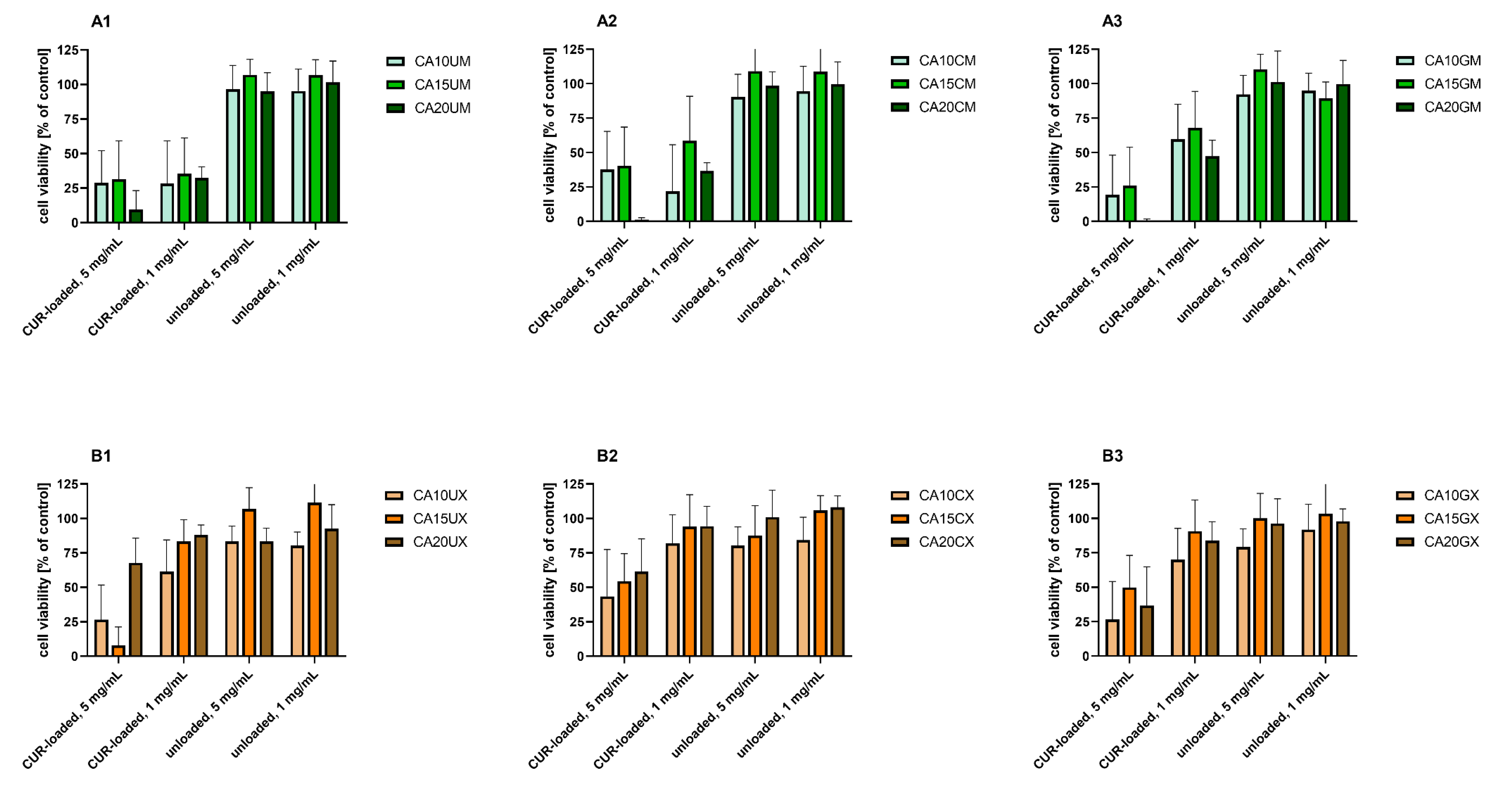
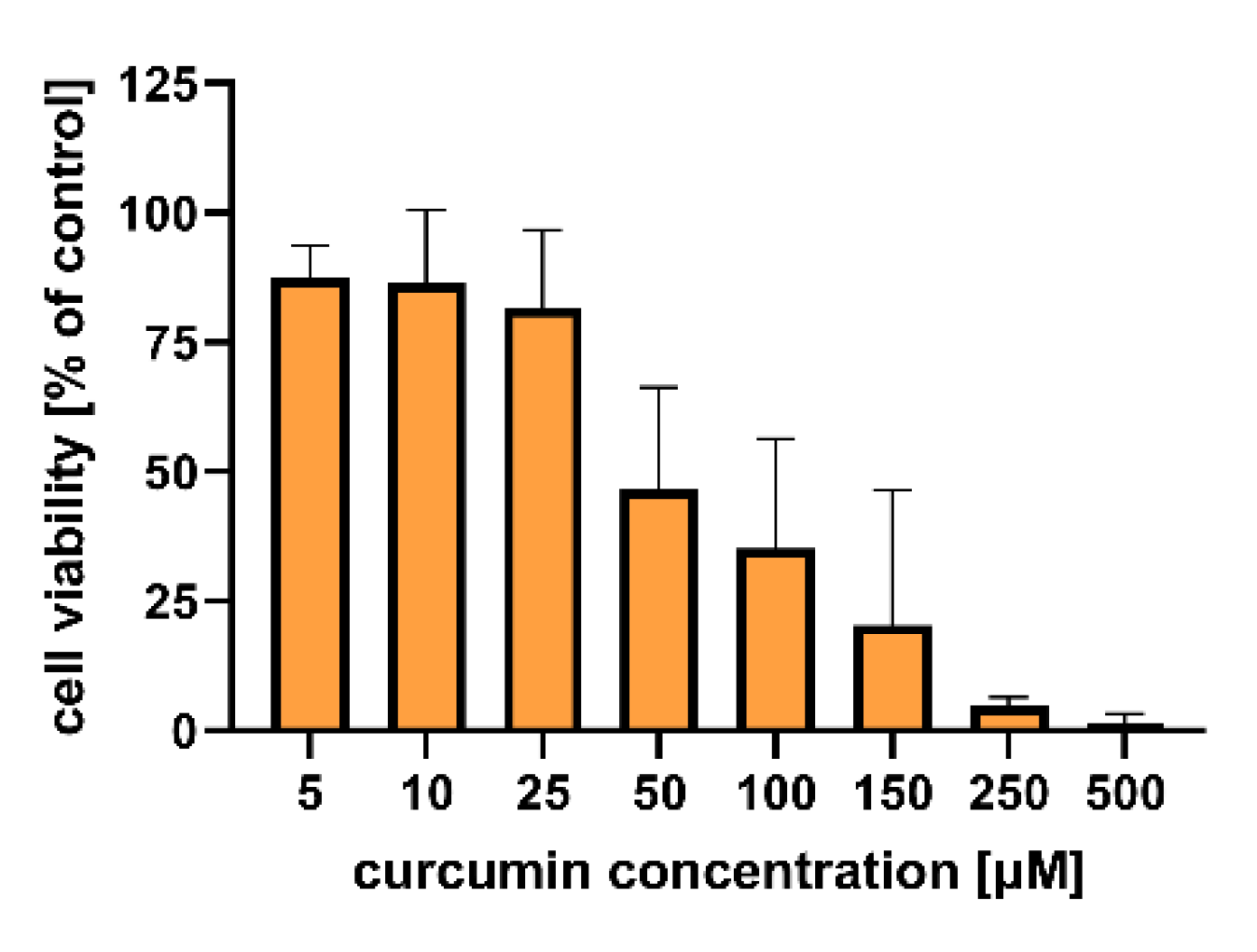
3. Materials and Methods
3.1. Materials
3.2. Fabrication of the CUR-Loaded Particles
3.3. Characterization of the CUR-Loaded Particles
3.3.1. SEM Analysis of the Particles Surface Morphology
3.3.2. Calculation of the Average Size of the Particles
3.3.3. Calculation of the Encapsulation Efficiency, the Moisture Content and the Swelling Index
3.4. FTIR Analysis
3.5. Studies on CUR Release Profile In vitro
 | Hybrid | |
 | Korsmeyer–Peppas | |
3.6. In Vitro Studies on the Cytotoxicity of CUR-Loaded Particles on Human Colon Adenocarcinoma Cells
3.7. Statistical Analysis
4. Conclusions
- The encapsulation efficiency differed significantly between micro- and macro-particles. Regardless of the structural composition, the microparticles encapsulated much less payload than the macroparticles.
- The structure of the particle (concentration of the core, polymer, presence and type of the external shell) affects its performance in simulated gastrointestinal conditions.
- Release profile studies revealed that CHIT-coated particles would be useful for carrying CUR to the intestine, as chitosan can dissolve in SGF and the burst phenomena were observed in SIF. On the other hand, uncoated and GEL-coated particles demonstrated a significant transfer of CUR to SCF and may be considered as useful systems for carrying CUR to the colon.
- The unloaded carriers were not cytotoxic to human colon adenocarcinoma cells, while the curcumin-loaded vehicles impaired their viability.
- The viability of colon cancer cells was more significantly reduced after incubation with curcumin-loaded microparticles than macroparticles.
- The potential anticancer activity of the proposed curcumin-loaded carriers requires further investigation.
Supplementary Materials
Author Contributions
Funding
Data Availability Statement
Conflicts of Interest
Sample Availability
References
- Atanasov, A.G.; Zotchev, S.B.; Dirsch, V.M.; The International Natural Product Sciences Taskforce; Supuran, C.T. Natural products in drug discovery: Advances and opportunities. Nat. Rev. Drug Discov. 2021, 20, 200–216. [Google Scholar] [CrossRef] [PubMed]
- Press, N.J.; Joly, E.; Ertl, P. Natural product drug delivery: A special challenge? Prog. Med. Chem. 2019, 58, 157–187. [Google Scholar]
- Patel, V.B.; Misra, S.; Patel, B.B.; Majumdar, A.P.N. Colorectal Cancer: Chemopreventive Role of Curcumin and Resveratrol. Nutr. Cancer 2010, 62, 958–967. [Google Scholar] [CrossRef] [Green Version]
- Kharat, M.; McClements, D.J. Recent advances in colloidal delivery systems for nutraceuticals: A case study—Delivery by Design of curcumin. J. Colloid Interface Sci. 2019, 557, 506–518. [Google Scholar] [CrossRef] [PubMed]
- Tomeh, M.A.; Hadianamrei, R.; Zhao, X. A Review of Curcumin and Its Derivatives as Anticancer Agents. Int. J. Mol. Sci. 2019, 20, 1033. [Google Scholar] [CrossRef] [PubMed] [Green Version]
- Mansouri, K.; Rasoulpoor, S.; Daneshkhah, A.; Abolfathi, S.; Salari, N.; Mohammadi, M.; Shabani, S. Clinical effects of curcumin in enhancing cancer therapy: A systematic review. BMC Cancer 2020, 20, 791. [Google Scholar] [CrossRef] [PubMed]
- Szlasa, W.; Szewczyk, A.; Drąg-Zalesińska, M.; Czapor-Irzabek, H.; Michel, O.; Kiełbik, A.; Cierluk, K.; Zalesińska, A.; Novickij, V.; Tarek, M.; et al. Mechanisms of curcumin-based photodynamic therapy and its effects in combination with electroporation: An in vitro and molecular dynamics study. Bioelectrochemistry 2021, 140, 107806. [Google Scholar] [CrossRef]
- Pricci, M.; Girardi, B.; Giorgio, F.; Losurdo, G.; Ierardi, E.; Di Leo, A. Curcumin and Colorectal Cancer: From Basic to Clinical Evidences. Int. J. Mol. Sci. 2020, 21, 2364. [Google Scholar] [CrossRef] [Green Version]
- Ramasamy, T.S.; Ayob, A.Z.; Myint, H.H.L.; Thiagarajah, S.; Amini, F. Targeting colorectal cancer stem cells using curcumin and curcumin analogues: Insights into the mechanism of the therapeutic efficacy. Cancer Cell Int. 2015, 15, 96. [Google Scholar] [CrossRef] [Green Version]
- Giordano, A.; Tommonaro, G. Curcumin and Cancer. Nutrients 2019, 11, 2376. [Google Scholar] [CrossRef] [Green Version]
- Rai, M.; Pandit, R.; Gaikwad, S.; Yadav, A.; Gade, A. Potential applications of curcumin and curcumin nanoparticles: From traditional therapeutics to modern nanomedicine. Nanotechnol. Rev. 2015, 4, 161–172. [Google Scholar] [CrossRef]
- Wong, K.E.; Ngai, S.C.; Chan, K.G.; Lee, L.H.; Goh, B.H.; Chuah, L.H. Curcumin Nanoformulations for Colorectal Cancer: A Review. Front. Pharmacol. 2019, 10, 152. [Google Scholar] [CrossRef]
- Stohs, S.J.; Chen, O.; Ray, S.D.; Ji, J.; Bucci, L.R.; Preuss, H.G. Highly Bioavailable Forms of Curcumin and Promising Avenues for Curcumin-Based Research and Application: A Review. Molecules 2020, 25, 1397. [Google Scholar] [CrossRef] [Green Version]
- Rafiee, Z.; Nejatian, M.; Daeihamed, M.; Jafari, S.M. Application of curcumin-loaded nanocarriers for food, drug and cosmetic purposes. Trends Food Sci. Technol. 2019, 88, 445–458. [Google Scholar] [CrossRef]
- Liu, W.; Zhai, Y.; Heng, X.; Che, F.Y.; Chen, W.; Sun, D.; Zhai, G. Oral bioavailability of curcumin: Problems and advancements. J. Drug Target. 2016, 24, 694–702. [Google Scholar] [CrossRef] [PubMed]
- Kulbacka, J.; Pucek, A.; Kotulska, M.; Dubińska-Magiera, M.; Rossowska, J.; Rols, M.P.; Wilk, K.A. Electroporation and lipid nanoparticles with cyanine IR-780 and flavonoids as efficient vectors to enhanced drug delivery in colon cancer. Bioelectrochemistry 2016, 110, 19–31. [Google Scholar] [CrossRef] [PubMed]
- Tsirigotis-Maniecka, M.; Szyk-Warszyńska, L.; Lamch, Ł.; Weżgowiec, J.; Warszyński, P.; Wilk, K.A. Benefits of pH-Responsive Polyelectrolyte Coatings for Carboxymethyl Cellulose-Based Microparticles in the Controlled Release of Esculin. Mater. Sci. Eng. C 2021, 118, 111397. [Google Scholar] [CrossRef]
- Albadran, H.; Monteagudo-Mera, A.; Khutoryanskiy, V.V.; Charalampopoulos, D. Development of chitosan-coated agar-gelatin particles for probiotic delivery and targeted release in the gastrointestinal tract. Appl. Microbiol. Biotechnol. 2020, 104, 5749–5757. [Google Scholar] [CrossRef] [PubMed]
- Martău, G.A.; Mihai, M.; Vodnar, D.C. The Use of Chitosan, Alginate, and Pectin in the Biomedical and Food Sector—Biocompatibility, Bioadhesiveness, and Biodegradability. Polymers 2019, 11, 1837. [Google Scholar] [CrossRef] [Green Version]
- Tsirigotis-Maniecka, M.; Szyk-Warszyńska, L.; Michna, A.; Warszyński, P.; Wilk, K.A. Colloidal Characteristics and Functionality of Rationally Designed Esculin-Loaded Hydrogel Microcapsules. J. Colloid Interface Sci. 2018, 530, 444–458. [Google Scholar] [CrossRef]
- Reig-Vano, B.; Tylkowski, B.; Montané, X.; Giamberini, M. Alginate-based hydrogels for cancer therapy and research. Int. J. Biol. Macromol. 2021, 170, 424–436. [Google Scholar] [CrossRef]
- Niu, B.; Jia, J.; Wanga, H.; Chen, S.; Cao, W.; Yan, J.; Gong, X.; Lian, X.; Li, W.; Fan, Y. In vitro and in vivo release of diclofenac sodium-loaded sodium alginate/carboxymethyl chitosan-ZnO hydrogel beads. Int. J. Biol. Macromol. 2019, 141, 1191–1198. [Google Scholar] [CrossRef]
- Braim, S.; Spiewak, K.; Brindell, M.; Heeg, D.; Alexander, C.; Monaghan, T. Lactoferrin-Loaded Alginate Microparticles to Target Clostridioides difficile Infection. J. Pharm. Sci. 2019, 108, 2438–2446. [Google Scholar] [CrossRef] [PubMed]
- Fu, Y.S.; Chen, T.H.; Weng, H.L.; Lai, D.; Weng, C.F. Pharmacological properties and underlying mechanisms of curcumin and prospects in medicinal potential. Biomed. Pharmacother. 2021, 141, 111888. [Google Scholar] [CrossRef] [PubMed]
- Li, Y.H.; Wang, Y.S.; Zhao, J.S.; Li, Z.Y.; Chen, H.H. A pH-sensitive curcumin loaded microemulsion-filled alginate and porous starch composite gels: Characterization, in vitro release kinetics and biological activity. Int. J. Biol. Macromol. 2021, 182, 1863–1873. [Google Scholar] [CrossRef] [PubMed]
- Saravanan, M.; Rao, K.P. Pectin–gelatin and alginate–gelatin complex coacervation for controlled drug delivery: Influence of anionic polysaccharides and drugs being encapsulated on physicochemical properties of microcapsules. Carbohydr. Polym. 2010, 80, 808–816. [Google Scholar] [CrossRef]
- Silverstein, R.M.; Webster, F.X.; Kiemle, D.J. Spectrometric Identification of Organic Compounds, 7th ed.; John Wiley & Sons, Inc.: New York, NY, USA, 2005. [Google Scholar]
- Queiroz, M.F.; Melo, K.R.T.; Sabry, A.S.; Sassaki, G.L.; Rocha, H.A.O. Does the Use of Chitosan Contribute to Oxalate Kidney Stone Formation? Mar. Drugs 2015, 13, 141–158. [Google Scholar] [CrossRef] [PubMed]
- Budinčić, J.M.; Petrović, L.; Đekić, L.; Fraj, J.; Bučko, S.; Katona, J.; Spasojević, L. A Study of vitamin E microencapsulation and controlled release from chitosan/sodium lauryl ether sulfate microcapsules. Carbohyd. Polym. 2021, 251, 116988. [Google Scholar] [CrossRef]
- Korsmeyer, R.W.; Gurny, R.; Doelker, E.; Buri, P.; Peppas, N.A. Mechanisms of Solute Release from Porous Hydrophilic Polymers. Int. J. Pharm. 1983, 15, 25–35. [Google Scholar] [CrossRef]
- Martins, A.F.; Facchi, S.P.; Monteiro, J.P.; Nocchi, S.R.; Silva, C.T.P.; Nakamura, C.V.; Girotto, E.M.; Rubira, A.F.; Muniz, E.C. Preparation and cytotoxicity of N,N,N-trimethyl chitosan/alginatebeads containing gold nanoparticles. Int. J. Biol. Macromol. 2015, 72, 466–471. [Google Scholar] [CrossRef] [Green Version]
- Javanbakht, S.; Shadi, M.; Mohammadian, R.; Shaabani, A.; Amini, M.M.; Pooresmaeil, M.; Salehi, R. Facile preparation of pH-responsive k-Carrageenan/tramadol loaded UiO-66 bio-nanocomposite hydrogel beads as a nontoxic oral delivery vehicle. J. Drug Deliv. Sci. Technol. 2019, 54, 101311. [Google Scholar] [CrossRef]
- Nia, S.B.; Pooresmaeil, M.; Namazi, H. Carboxymethylcellulose/layered double hydroxides bio-nanocomposite hydrogel: A controlled amoxicillin nanocarrier for colonic bacterial infections treatment. Int. J. Biol. Macromol. 2020, 155, 1401–1409. [Google Scholar]
- Jabbari, E.; Yang, X.; Moeinzadeh, S.; He, X. Drug release kinetics, cell uptake, and tumor toxicity of hybrid VVVVVVKK peptide-assembled polylactide nanoparticles. Eur. J. Pharm. Biopharm. 2013, 84, 49–62. [Google Scholar] [CrossRef] [PubMed] [Green Version]
- Slika, L.; Moubarak, A.; Borjac, J.; Baydoun, E.; Patra, D. Preparation of curcumin-poly (allyl amine) hydrochloride based nanocapsules: Piperine in nanocapsules accelerates encapsulation and release of curcumin and effectiveness against colon cancer cells. Mater. Sci. Eng. C 2020, 109, 110550. [Google Scholar] [CrossRef]
- Tsirigotis Maniecka, M.; Szyk-Warszyńska, L.; Maniecki, Ł.; Szczęsna, W.; Warszyński, P.; Wilk, K.A. Tailoring the composition of hydrogel particles for the controlled delivery of phytopharmaceuticals. Eur. Polym. J. 2021, 151, 110429. [Google Scholar] [CrossRef]
- Chavarri, M.; Maranon, I.; Ares, R.; Ibanez, F.C.; Marzo, M.; del Carmen Villaran, M. Microencapsulation of a Probiotic And Prebiotic in Alginate-Chitosan Capsules Improves Survival in Simulated Gastro-Intestinal Conditions. Int. J. Food Microbiol. 2010, 142, 185–189. [Google Scholar] [CrossRef]
- Marques, M.R.C.; Loebenberg, R.; Almukainzi, M. Simulated Biological Fluids with Possible Application in Dissolution Testing. Dissolution Technol. 2011, 18, 15–28. [Google Scholar] [CrossRef]

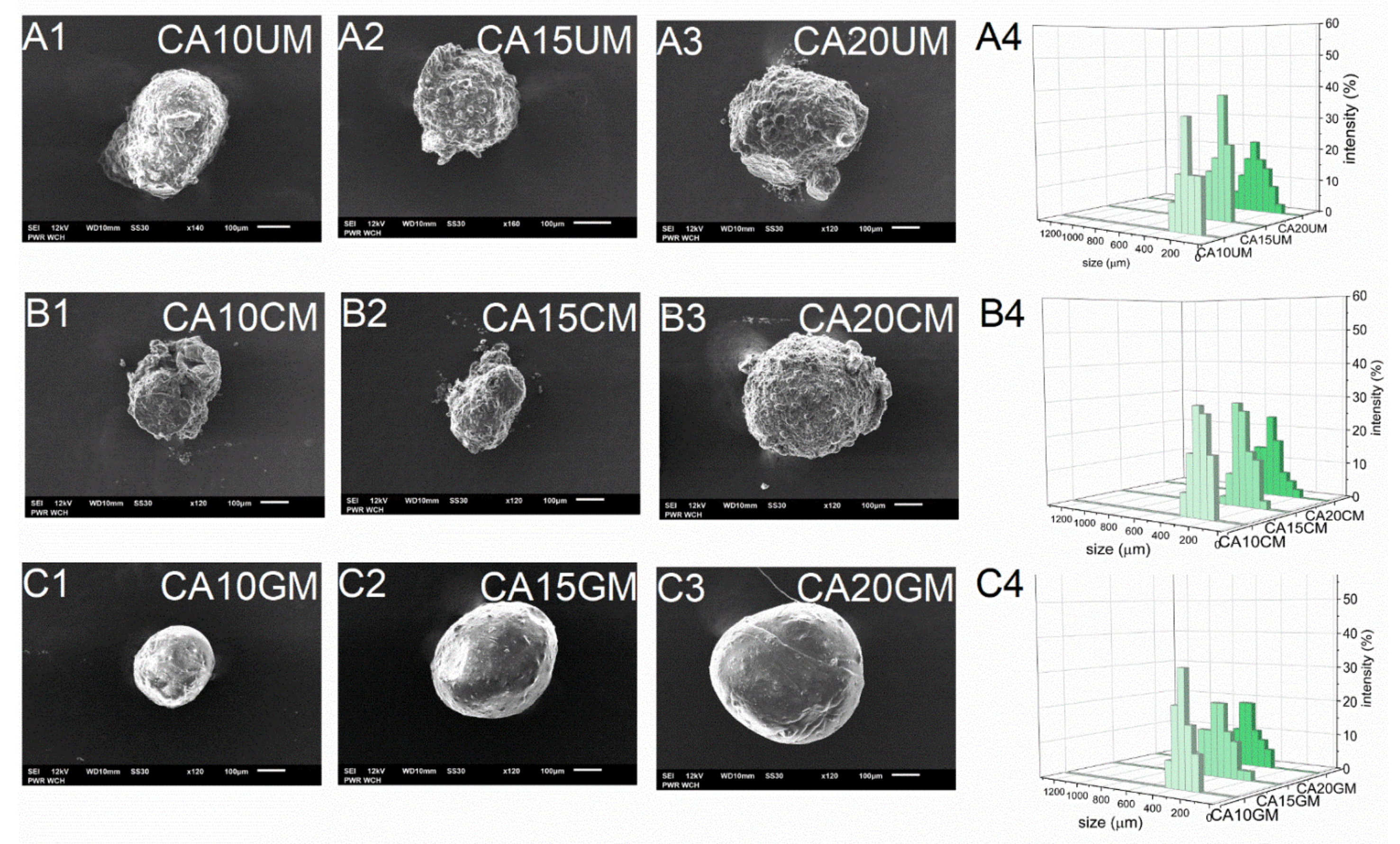
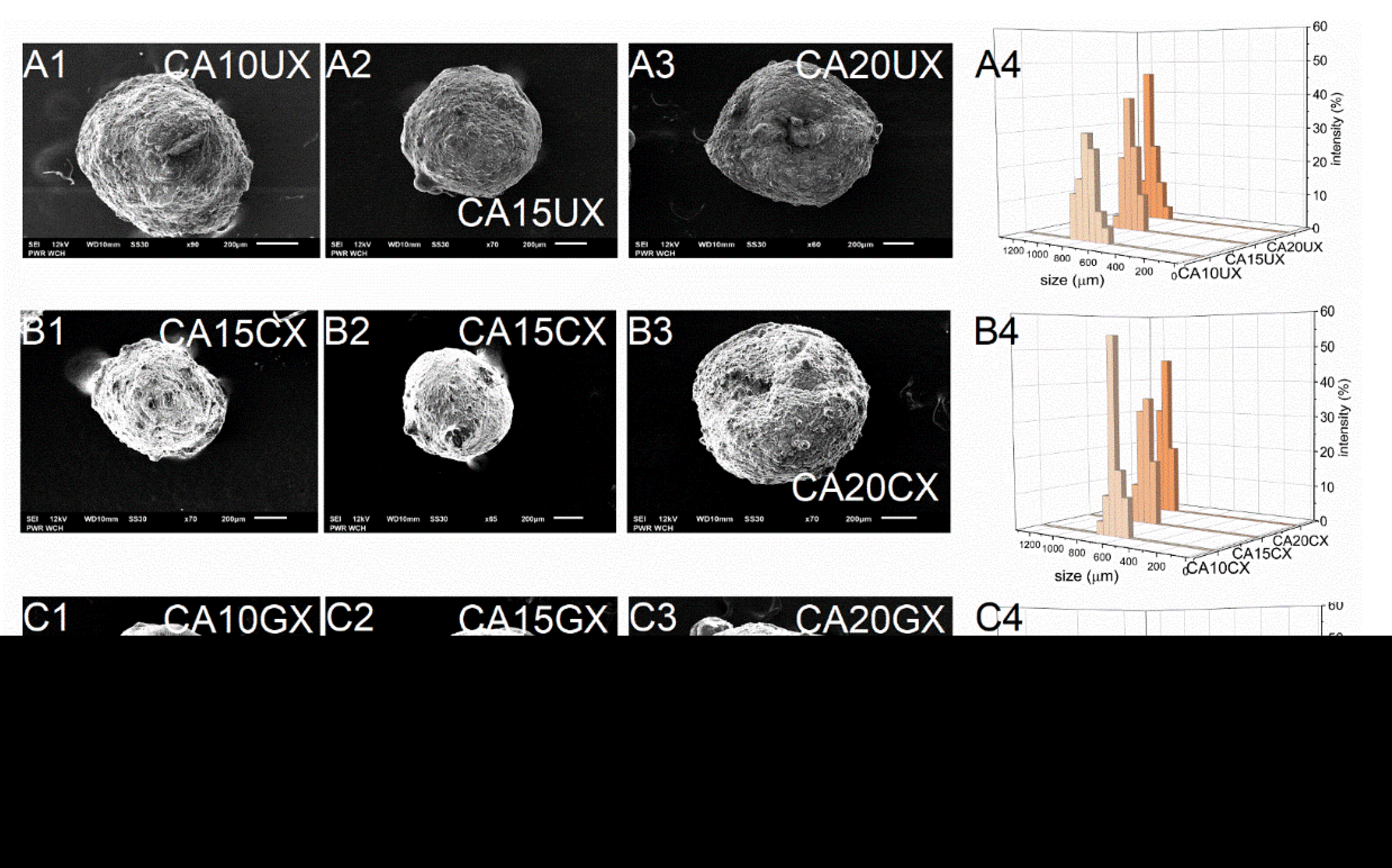
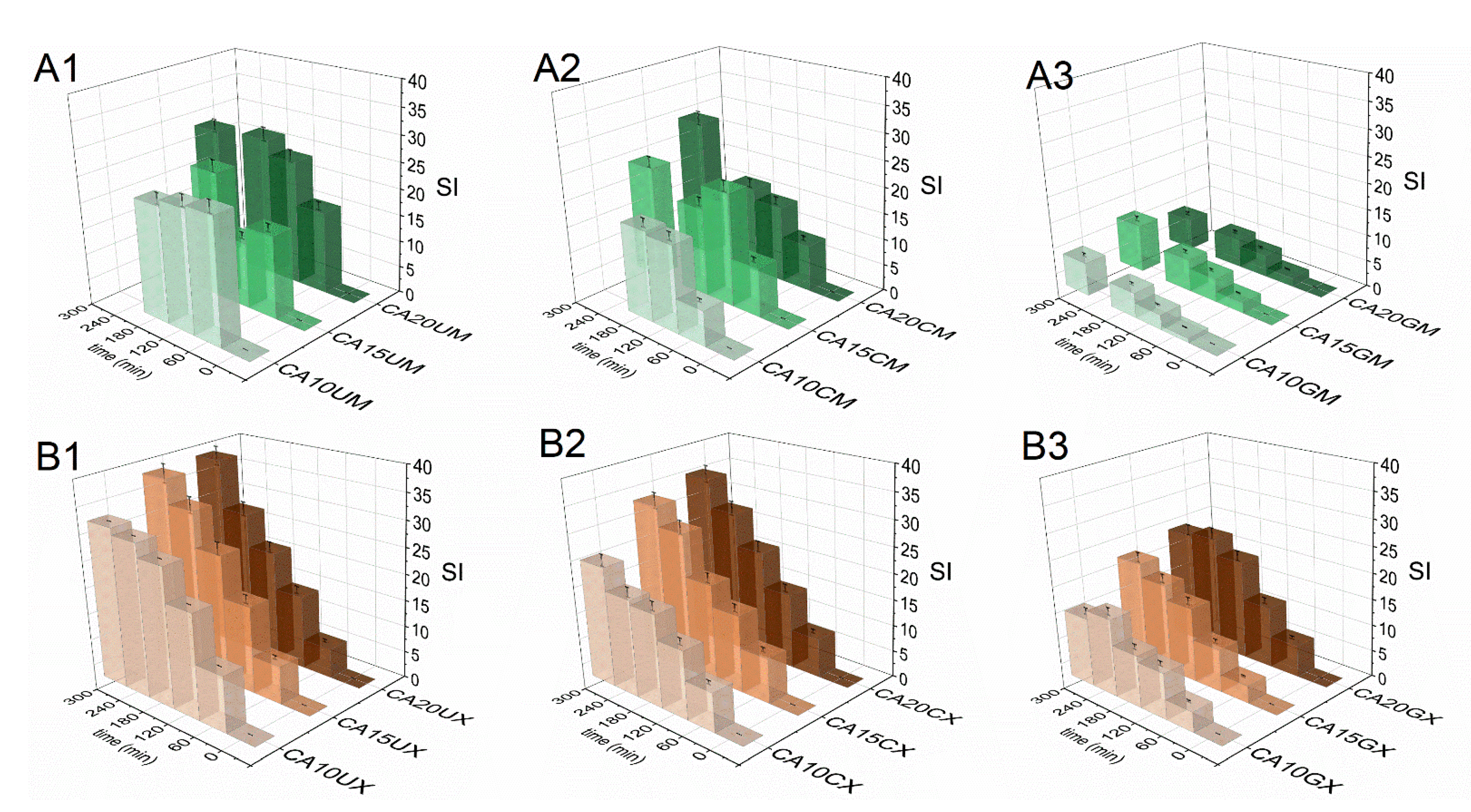

| H-Model | KP-Model | |||||||
|---|---|---|---|---|---|---|---|---|
| Particle | SGF Stage | |||||||
| MH1 | kH1 | kH2 | nH1 | RH12 | kKP1 | nKP1 | RKP12 | |
| CA10UM | 3.01 | 3.4 × 10−4 | 3.6 × 10−6 | 2.90 | 0.952 | |||
| CA15UM | 0.22 | 1.3 × 10−2 | 2.6 × 10−1 | 0.86 | 0.996 | |||
| CA20UM | 0.00 | 5.0 × 10−2 | 5.3 × 10−7 | 3.87 | 0.961 | |||
| CA10CM | 7.4 × 10−2 | 1.14 | 0.910 | |||||
| CA15CM | 9.4 × 10−2 | 1.02 | 0.988 | |||||
| CA20CM | 8.6 × 10−2 | 1.06 | 0.979 | |||||
| CA10GM | 0.03 | 6.1 × 10−1 | 9.8 × 10−2 | 1.04 | 0.968 | |||
| CA15GM | 0.01 | 1.3 × 10−7 | 1.2 × 10−14 | 6.69 | 0.901 | |||
| CA20GM | 0.01 | 1.2 × 10−1 | 2.0 × 10−16 | 7.02 | 0.981 | |||
| CA10UX | 0.07 | 1.0 × 10−3 | 1.7 × 10−4 | 0.87 | 0.979 | |||
| CA15UX | 0.01 | 1.7 × 10−3 | 1.5 × 10−8 | 3.43 | 0.978 | |||
| CA20UX | 0.01 | 4.4 × 102 | 6.1 × 10−4 | 1.84 | 0.969 | |||
| CA10CX | 2.9 × 10−4 | 2.17 | 0.917 | |||||
| CA15CX | 1.2 × 10−1 | 0.86 | 0.926 | |||||
| CA20CX | 0.00 | 5.4 × 10−2 | 5.1 × 10−18 | 7.57 | 0.991 | |||
| CA10GX | 0.00 | 2.0 × 1010 | 3.8 × 10−4 | 2.72 | 0.956 | |||
| CA15GX | 0.00 | 5.0 × 10−2 | 3.8 × 10−5 | 2.12 | 0.962 | |||
| CA20GX | 0.01 | 1.0 × 10−3 | 1.0 × 10−3 | 0.89 | 0.854 | |||
| Particle | SIF Stage | |||||||
| MH2 | kH3 | kH4 | nH2 | RH22 | kKP2 | nKP2 | RKP22 | |
| CA10UM | 0.005 | 1.0 × 10−3 | 7.5 × 10−4 | 1.30 | 0.989 | |||
| CA15UM | 0.005 | 1.0 × 10−3 | 3.8 × 10−3 | 0.87 | 0.975 | |||
| CA20UM | 0.005 | 1.0 × 10−3 | 1.8 × 10−3 | 1.04 | 0.950 | |||
| CA10CM | 2.8 × 10−1 | 0.27 | 0.891 | |||||
| CA15CM | 2.1 × 10−1 | 0.29 | 0.908 | |||||
| CA20CM | 3.2 × 10−2 | 0.42 | 0.984 | |||||
| CA10GM | 0.005 | 1.0 × 10−3 | 1.0 × 10−5 | 2.16 | 0.965 | |||
| CA15GM | 0.005 | 1.0 × 10−3 | 2.9 × 10−4 | 1.46 | 0.993 | |||
| CA20GM | 0.005 | 1.0 × 10−3 | 2.9 × 10−3 | 0.86 | 0.996 | |||
| CA10UX | 0.005 | 1.0 × 10−3 | 5.6 × 10−4 | 1.38 | 0.976 | |||
| CA15UX | 0.005 | 1.0 × 10−3 | 1.0 × 10−5 | 2.14 | 0.967 | |||
| CA20UX | 0.005 | 1.0 × 10−3 | 2.3 × 10−5 | 1.72 | 0.988 | |||
| CA10CX | 0.005 | 1.0 × 10−3 | 4.3 × 10−7 | 1.10 | 0.882 | |||
| CA15CX | 0.005 | 1.0 × 10−3 | 3.6 × 10−5 | 2.12 | 0.894 | |||
| CA20CX | 0.005 | 1.0 × 10−3 | 1.0 × 10−5 | 2.32 | 0.955 | |||
| CA10GX | 1.8 × 10−7 | 3.25 | 0.996 | |||||
| CA15GX | 0.005 | 1.0 × 10−3 | 1.7 × 10−4 | 1.70 | 0.928 | |||
| CA20GX | 1.2 × 10−8 | 3.53 | 0.944 | |||||
| Particle | SCF Stage | |||||||
| MH3 | kH5 | kH6 | nH3 | RH32 | kKP3 | nKP3 | RKP32 | |
| CA10UM | 4.7 × 10−1 | 0.14 | 0.997 | |||||
| CA15UM | 3.1 × 10−1 | 0.21 | 0.997 | |||||
| CA20UM | 2.9 × 10−1 | 0.08 | 0.972 | |||||
| CA10CM | 8.8 × 10−1 | 0.02 | 0.999 | |||||
| CA15CM | 7.6 × 10−1 | 0.04 | 0.993 | |||||
| CA20CM | 7.3 × 10−1 | 0.02 | 0.999 | |||||
| CA10GM | 0.005 | 1.0 × 10−3 | 2.6 × 10−4 | 1.41 | 0.971 | |||
| CA15GM | 0.005 | 1.0 × 10−3 | 4.2 × 10−2 | 0.86 | 0.991 | |||
| CA20GM | 0.005 | 1.0 × 10−3 | 3.1 × 10−3 | 1.04 | 0.943 | |||
| CA10UX | 4.0 × 10−1 | 0.14 | 0.997 | |||||
| CA15UX | 2.9 × 10−1 | 0.14 | 0.983 | |||||
| CA20UX | 1.1 × 10−1 | 0.29 | 0.968 | |||||
| CA10CX | 8.2 × 10−1 | 0.04 | 0.999 | |||||
| CA15CX | 8.5 × 10−1 | 0.02 | 0.999 | |||||
| CA20CX | 7.0 × 10−1 | 0.03 | 0.994 | |||||
| CA10GX | na | na | na | na | na | na | na | na |
| CA15GX | 5.3 × 10−1 | 0.12 | 0.995 | |||||
| CA20GX | 4.4 × 10−1 | 0.18 | 0.966 | |||||
Publisher’s Note: MDPI stays neutral with regard to jurisdictional claims in published maps and institutional affiliations. |
© 2021 by the authors. Licensee MDPI, Basel, Switzerland. This article is an open access article distributed under the terms and conditions of the Creative Commons Attribution (CC BY) license (https://creativecommons.org/licenses/by/4.0/).
Share and Cite
Wezgowiec, J.; Tsirigotis-Maniecka, M.; Saczko, J.; Wieckiewicz, M.; Wilk, K.A. Microparticles vs. Macroparticles as Curcumin Delivery Vehicles: Structural Studies and Cytotoxic Effect in Human Adenocarcinoma Cell Line (LoVo). Molecules 2021, 26, 6056. https://doi.org/10.3390/molecules26196056
Wezgowiec J, Tsirigotis-Maniecka M, Saczko J, Wieckiewicz M, Wilk KA. Microparticles vs. Macroparticles as Curcumin Delivery Vehicles: Structural Studies and Cytotoxic Effect in Human Adenocarcinoma Cell Line (LoVo). Molecules. 2021; 26(19):6056. https://doi.org/10.3390/molecules26196056
Chicago/Turabian StyleWezgowiec, Joanna, Marta Tsirigotis-Maniecka, Jolanta Saczko, Mieszko Wieckiewicz, and Kazimiera A. Wilk. 2021. "Microparticles vs. Macroparticles as Curcumin Delivery Vehicles: Structural Studies and Cytotoxic Effect in Human Adenocarcinoma Cell Line (LoVo)" Molecules 26, no. 19: 6056. https://doi.org/10.3390/molecules26196056
APA StyleWezgowiec, J., Tsirigotis-Maniecka, M., Saczko, J., Wieckiewicz, M., & Wilk, K. A. (2021). Microparticles vs. Macroparticles as Curcumin Delivery Vehicles: Structural Studies and Cytotoxic Effect in Human Adenocarcinoma Cell Line (LoVo). Molecules, 26(19), 6056. https://doi.org/10.3390/molecules26196056








